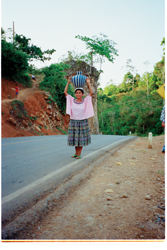Billions of the world's poorest are being denied even the most basic natural resource.
Most of us in the west have grown used to thinking about scarcity and conservation when we switch on the heat in our homes or turn the key in our car ignitions. But in the developing world it's not filling up the Humvee that keeps parents up at night; it's finding enough clean water to get through the next day.
Potable water is a finite natural resource essentially taken for granted in the industrialized world. It was the abundance of water, in fact, that helped drive the industrial revolution in the first place. Since that time folks in the United States and throughout most of the Western world continue to exploit this increasingly scarce natural resource as if an endless supply of fresh water were raining down from the heavens. Despite appearances to the contrary in more temperate climates, the truth is the global tap is actually in danger of running dry, and in many poor nations it already has.
Beyond the obvious threat to mere survival, fresh water scarcity creates a ripple effect through the socio-economic life of some of the world's poorest and most vulnerable people. According to the 2006 United Nations' Human Development Report, which focused on the global water crisis, more than 1 billion people "are denied the right to clean water," and 2.6 billion people lack access to adequate sanitation. In a sad irony, it is the world's poorest who pay the most for access to clean water, but there are even more devastating costs associated with the global water crisis.
Each year 1.8 million children are killed by diarrhea and other easily preventable diseases caused by dirty water and poor sanitation. Inadequate sanitation remains the world's second biggest killer of children despite the widespread availability of low-tech alternatives that could prevent that appalling ferryman's toll. In fact as some of us enter the 21st century thumbing BlackBerry communicators and longing for HDTV, almost 20 percent of the planet's inhabitants still drink dirty water collected from filthy puddles in the street, rain runoff, or contaminated ponds, rivers, and streams.
But child mortality is not the only problem flowing out of the world's water crisis. Millions of women and young girls throughout the developing world begin each morning with an arduous ritual of finding and collecting water for their families-a daily burden that helps sustain gender inequalities in employment and education, according to the U.N. And poor health associated with water and sanitation deficits undermines productivity and economic growth, "reinforcing the deep inequalities that characterize current patterns of globalization and trapping vulnerable households in cycles of poverty."
It would be easy to blame the world's dirty water on simple scarcity, but U.N. researchers say the issue is more complex. While the roots of the crisis can be traced to sometimes epically wrongheaded water management strategies, "poverty, inequality, and unequal power relationships" also share the blame.
Although halving the number of people without access to safe water is among the ambitious U.N. Millennium Challenge Goals (MCG), in recent years Western nations, adopting a Marie Antionettish "let them drink bottled water" indifference, have relied on the free market to resolve this particular trickle-down effect. Free market entrepreneurs have responded predictably by commoditizing what had essentially been regarded as a free resource and privatizing traditional sources of water so that some of the poorest people in the world now have to pay dearly for one of life's absolute essentials.
Water, like health care and adequate nutrition, needs to be considered a basic human right guaranteed to all, not a for-profit commodity for sale to the highest bidder. That is not to say that some combination of private and public initiatives would not prove the best mechanism to ensure water delivery to the world's thirsty, but more needs to be done now to see that practically achieved. Fully funding the U.N.'s efforts to meet the MCG on water would require a mere $4 billion more each year until 2015. That is one small step toward keeping the water of life flowing.











Add comment